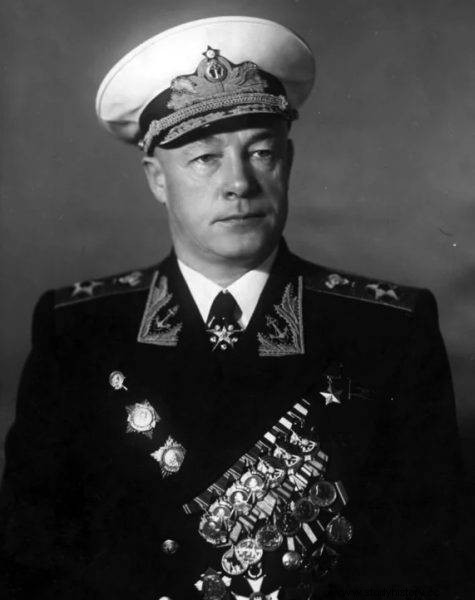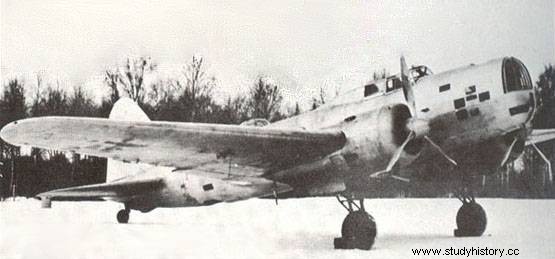After the German invasion of the Soviet Union on On June 22, 1941, the Red Army experienced severe defeats. The enemy was occupying more towns and villages. Nevertheless, in a situation where the defeat of their country seemed inevitable, in August 1941 Soviet pilots raided ... Berlin.
On the night of July 22, 1941, the Luftwaffe conducted a massive raid on Moscow. Almost 200 aircraft participated in the operation. Although they failed to destroy the Soviet capital, its inhabitants and citizens throughout the Soviet Union felt depressed. The fact that enemy air force reached Moscow meant that Germany was becoming more and more comfortable in its country, and the specter of occupation loomed over the city. The People's Commissar of the Navy, Admiral Nikolai Kuznetsov, proposed a retaliatory raid on the capital of the Reich. His plan was supported by Joseph Stalin, who appointed the commander of the air force - General Semyon Żaworonkov - commander of Operation "B" ("Berlin").
Read also:Operation Chastice. How did English pilots try to sink the Third Reich?
"Soviet aviation does not exist"
On August 7, 1941, a special strike group of 15 Soviet bombers left the airport on the island of Sarema (the largest Estonian island in the Baltic Sea, south of the entrance to the Gulf of Finland). Then she reached Berlin and dropped the first bombs on him. Their actions shocked the German and world public opinion.

Admiral Nikolai Kuznetsov, proposed a retaliatory raid on the capital of the Reich
The success of Operation "B" proved that the argument of the Propaganda Minister of the Third Reich, Josef Goebbels, that "Soviet aviation no longer exists", is not entirely true.
However, it must be admitted that in the first hours of the war, Luftwaffe planes destroyed all Soviet border airfields, and most of the machines did not even manage to crash into the air. Of the several thousand aircraft stationed in the western military districts, only a few hundred have survived. Thus, the German pilots began to reign in the Soviet skies. The enemy took over large military airports in the vicinity of Minsk, Smolensk, Orsza and Vitebsk.
In this situation, the country urgently needed, if not a real, then at least psychological victory over the enemy . That is why there was a plan to attack the Germans in response to the air raids on Moscow - it was supposed to refute the myth about the invincible Nazi army.
Read also:Junkersy w ogniu. The Home Army in the fight against the Luftwaffe
Quick preparations
It was impossible to reach Berlin from the Western Front, because Soviet bombers in both directions could not cover more than 2,000 km. It was then that the idea of using the airport on the Estonian island of Saarema, which was still controlled by the Soviet army, was born. On July 26, Semyon Zhavoronkov and Nikolai Kuznetsov presented the action plan to Joseph Stalin and obtained his approval.

In order for the planes not to be detected by the enemy, during the operation the pilots were to fly at maximum altitude, without radio communication and with oxygen masks on their faces
In the last days of July, a large supply of fuel and aerial bombs arrived by sea from Kronstadt, the main base of the Soviet Baltic Fleet. Extended runways at the airport. Colonel Yevgeny Preobrażeński was appointed the commander of the strike group, who calculated the course of the flight literally down to the minute.
In order for the planes not to be detected by the enemy, during the operation the pilots were to fly at maximum altitude, without radio communication and with oxygen masks on their faces . One machine could carry one 500 kg bomb or two 250 kg bomb.
On the night of August 4/5, five planes made a reconnaissance flight towards the German capital.
Read also:Massacre of German civilians by the Allies. The carpet raids on Dresden, February 13–15, 1945
Soviet success
On August 7, at 21:00, 15 bombers, divided into three groups, took off from the airport on the island of Saarema. The outside temperature was minus 35-40 ° C. After three hours of flight, the planes reached the northern border of Germany. During the flight over enemy territory, Soviet bombers were repeatedly detected by German vantage points, but the anti-aircraft defense did not open fire, considering that it had its own planes in front of it.
On August 8, at 2 a.m., the pilots reached the beautifully lit Berlin. The German command was so confident in the safety of the capital that the blackout of the city was abandoned. The pilots bombed a new industrial area, railway station and telegraph point. The Germans were so shocked by the actions of the Soviet military that they did not immediately react to the hostile actions of the Soviets .
After completing the task, all planes managed to return to base. From August 8 to September 4, Soviet soldiers carried out 36 air raids on the German capital. They dropped 36 tons of bombs and 34 containers with propaganda leaflets and newspapers.

Saarema Island, Estonia
Of course, the relatively small number of bombers was not able to inflict damage comparable to those that hit Moscow. But much more important was the psychological effect produced in Germany. It was a cheek to Goebbels, who assured that no enemy aircraft would manage to reach the Reich's capital .
The Wehrmacht Command - taking into account the constant defeats suffered by the Red Army - could not have imagined that the perpetrators of the confusion were Soviet planes. The next day, the Germans publicly accused the British of dropping bombs on Berlin and causing serious damage there . London insisted that English planes were not in the vicinity of Berlin at the time. The mystery was solved by the Soviet side when on August 10 the Pravda newspaper published information about an effective raid on the capital of Nazi Germany. From the first day of the raid, the quiet life of Berliners ended, who spent almost a month in cellars and shelters.
Unfortunately, during the implementation of Operation "B", Colonel Preobrażeński's unit lost 17 or 18 aircraft. An interesting fact is that the machines were shot down by ... own anti-aircraft defense. This was because the undertaking was kept strictly secret, so the Soviet military assumed that the planes passing over them belonged to the enemy.
On August 13, 1941, the commander of the group, Yevgeny Preobrażeński, and 4 pilots were awarded the title of Hero of the Soviet Union. The rest were presented with other high prizes.
Read also:Night witches. Soviet female aviators were feared among the Nazis
